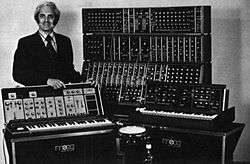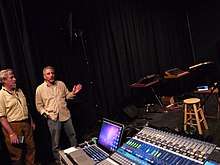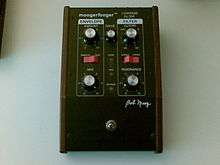Moog Music
Moog Music Inc. is an American company based in Asheville, North Carolina, which manufactures electronic musical instruments. It was founded in 1953 as R. A. Moog Co. by Robert Moog and his father, and was renamed Moog Music in 1972. Its early instruments included various Moog modular synthesizer systems, including the world's first commercial synthesizer, followed by the launch of the Minimoog in 1970, which became one of the most coveted and influential electronic instruments of all time.
 | |
 Exterior of Moog Music building in Asheville, North Carolina | |
| Corporation | |
| Founded | 1953 (as R. A. Moog Co.) New York City, New York, U.S. |
| Founder | Robert Moog |
| Headquarters | Asheville, North Carolina, U.S. |
Key people | Robert Moog, founder Mike Adams, president |
| Products | Synthesizers, Musical instruments, Signal processing |
| Website | www.moogmusic.com |
In 1971, following a recession, Robert Moog sold Moog Music to Norlin Musical Instruments, where he remained employed as a designer until 1977. In 1978, he founded a new company, Big Briar. Moog Music declared bankruptcy in 1987, and the Moog Music trademark was returned to Robert Moog in 2002, when Big Briar resumed operations under the name Moog Music.
Moog Music also manages Moogfest, a pioneering electronic music and music technology festival in Durham, NC.
History
1953–1967: R. A. Moog Co.



Robert Moog founded R. A. Moog Co. with his father in 1953 at the age of 19 in Trumansburg, New York, selling theremin kits to finance his college and graduate school education.[1] In 1963, experimental composer Herbert Deutsch introduced himself to Moog at a music education conference in Rochester, New York after Deutsch had built a theremin following Moog's design.[2] The two of them worked together to build the first modular voltage-controlled synthesizer.
1967–1971: R. A. Moog, Inc.
By 1967, R. A. Moog, Co. had become a larger enterprise, continuing to sell its theremin kits but with sales mainly focused on the commercial Moog synthesizer.[2] Though the Moog synthesizer's sound had rapidly become iconic with the success of Wendy Carlos's Switched-On Bach, the instrument nonetheless did not sell well due to its size and impracticality. The company gradually ran deep into debt, turning a profit only one year of its existence – 1969, following the 'Switched-On' sensation ignited by Carlos.[3]
1971–1977: Moog Musonics, Moog Music, Inc., changes of management, and financial duress
In November 1971, rival company muSonics bought R. A. Moog, Inc. and relocated the company to Williamsville, New York. An old factory at the north end of Academy Street was purchased. The company was renamed Moog Musonics, then Moog Music, Inc.[2]
In 1972, former televangelist and successful salesman David VanKouvering joined the company as VP of Marketing, creating a network of retail stores throughout the United States and then the entire world.[3] Despite the increased commercial success the company saw with the introduction of the Minimoog than with previous products, competition with contemporary manufacturers such as ARP Instruments, Oberheim Electronics, and Electronic Music Studios drove the company steadily deeper into debt.[4][5] Moog Music, Inc. was ultimately sold to Norlin Industries in 1973. At this point, rival companies such as the aforementioned ARP Instruments were producing both monophonic and polyphonic synthesizers that rapidly outpaced the Moog in popularity. By 1975, ARP owned 40% of the synthesizer market share, effectively boxing out Moog Music, Inc.[6]
In 1976, Norlin moved the company to a facility on Walden Avenue in Cheektowaga. In 1977, once his contract with Norlin expired, Robert Moog officially left the company to pursue his own ventures, founding the firm Big Briar.[7]
1978–1987: Contract manufacturing, digital synthesis, and bankruptcy
By 1978, Moog Music, Inc. had released a number of followup products after the success of the Minimoog, including the Vocoder, the Multimoog, the Polymoog, and a series of Taurus bass pedals.[2] Despite numerous artists taking up these products, none of these synthesizers ever achieved the same level of success that the Minimoog did.[8] As such, the company began contract manufacturing in 1981 in various other industries, including subway system repairs and air conditioning systems.[9]
Around the same time, digital synthesis was swiftly becoming a viable alternative to analog synthesizers. The Fairlight CMI, released 1979, was an expensive though fully formed digital synthesizer and sampler;[10] in 1983, the introduction of the MIDI interface allowed rival Yamaha to release the world's first commercially successful digital synthesizer, the DX7.[11] Though Moog Music, Inc. would attempt to pivot its business model to produce digital synthesizers, the company officially declared bankruptcy in 1987.[7]
2000–present: Legal battle, Moog Music Inc.'s return to Robert Moog, analog revival, and transition to employee owned model
As digital synthesizers rapidly became ubiquitous, the 1990s saw a rise in nostalgia for the iconic analog sound of Moog and Minimoog synthesizers, with musicians like David Foster continuing to use them. Minimoogs began fetching high prices as collector's items.[6] In 1994, the Moog Music trademark expired and was purchased by Don Martin; a legal battle ensued in 2000 over ownership of the name, and it was ultimately returned to Robert Moog in 2002.[7]
The company moved to Asheville, North Carolina, and continued its development of products created under Robert Moog's former company Big Briar, such as the Moogerfooger pedals and theremins, as well as introducing numerous new products such as the Minimoog Voyager, Little Phatty, Sub 37, and Mother 32 some of which continue to be produced and sold today.[1] The company has seen fiscal growth and increased interest due in part to the analog revival, evidenced by the introduction of so many new analog synthesizers being released by companies such as Moog, Korg, Arturia, and Dave Smith Instruments, that has continued climbing to reach a high point in the 2010s.[12][13]
After Robert Moog died in 2005 due to complications arising from brain cancer,[14] his collaborator Michael Adams took over the company as president.[7] The company has since shifted to being largely employee owned, with its 62 employees owning 49% of the company's shares in 2015.[15] The company has in recent years seen the results of a strong incentive to introduce new products to meet the demands generated by today's market and have also produced limited edition reissues of historic Moog synthesizers as well as reaching out into the emerging Eurorack synthesizer market with instruments such as the semi-modular synthesizers, the Mother 32, DFAM, Grandmother, Matriarch, and Subharmonicon.[16]
Major products
1964 – Moog synthesizer
_%40_Stearns_Collection_(Stearns_2035)%2C_University_of_Michigan.jpg)
At the prompting of composer Herbert Deutsch, Moog invented his now iconic Moog modular synthesizer in 1964. Defined by its use of modules, or independent circuits that performed distinctive tasks – oscillators, filters, amplifiers, envelope generators – the Moog synthesizer allowed users to connect different modules in arbitrary configurations to create remarkably complex sounds. Famously, it also employed a keyboard interface, as opposed to contemporary synthesizer manufacturer Buchla Electronic Musical Instruments who chose to explore alternative control methods instead of using the immediately familiar piano-like interface.[3]
Moog went on to present the synthesizer at the 1964 Audio Engineering Society conference, where it rapidly gained notoriety.[7] The Moog saw some measure of success as experimental artists as Paul Beaver, Suzanne Ciani, and David Borden began to employ it in their work,[4] and the rise of psychedelic rock in the 1960s saw numerous commercial artists employ the Moog in their music, including The Byrds, The Beatles, The Rolling Stones, and The Doors.[17]
Perhaps the greatest commercial success for the Moog synthesizer arrived in 1968 with Wendy Carlos's seminal album Switched-On Bach selling over a million copies and winning three Grammy Awards. The success of that album prompted a brief fad of 'Switched-On' music that faded away by 1970.[3]
1970 – Minimoog
Despite the success of the Moog, its relatively large size made it impractical for general use. Together with engineers Jim Scott and Bill Hemsath, Moog built the Minimoog. The Minimoog employed the minimal number of modules possible and did away with patch cords, instead hardwiring the various modules together. Furthermore, the Minimoog introduced the pitch wheel, enabling vibrato and pitch-bending an interval of a perfect fifth above or below the note played on the keyboard.[7] Its compact size and range of available sounds allowed the Minimoog to be a comparative success, selling over 13,000 units over the next decade.[2] Pink Floyd, Stevie Wonder, Herbie Hancock, Emerson, Lake & Palmer, and Tangerine Dream were among the numerous musicians who used the Minimoog.
Other variations on the Minimoog continued to be produced, until the company simply decided to re-release the Minimoog in 2016.[9]
1975 – Taurus

The first true Moog bass instrument was the Moog Taurus, a pedal-operated analog synthesizer.[2] Like the Moog, it remained a monophonic analog subtractive synthesizer, initially with 13 pedals in its first model. The Taurus II was expanded to include 18 pedals, and the Taurus III returned to 13.[18]
The Taurus was picked up by various progressive rock bands, including Led Zeppelin, Yes, Genesis, and Dream Theater.[19]
1978 – Vocoder
Though Moog had developed his own vocoder in 1968, Moog Music's commercial product was not released until 1978 and was based almost entirely on Harald Bode's design.[2] Many other companies already were releasing their own vocoders, including Korg, Roland, Electronic Music Studios, and more.[20] Its lack of support for MIDI has made it less enduringly popular than its counterparts. Musicians who used the Moog Vocoder include Saga (band), Wendy Carlos, The Moog Cookbook, and filmmaker/composer John Carpenter.[21]
1998 – Moogerfooger

The Moogerfooger, introduced under Big Briar, is an analog effects pedal that essentially allowed users to apply the modules that constituted the original Moog design to arbitrary sound inputs.[22] Some of the effects included ring modulation, low-pass filtration, ladder filtration, and flanging.[23] The Moogerfooger was successful, and saw a variety of models produced. It was discontinued in 2018, after 20 years of production.[24]
2002 – Minimoog Voyager
In 2002, on reacquiring the Moog Music trademark, the company began to produce the Minimoog Voyager, effectively an updated version of the iconic Minimoog. The Voyager famously featured a true analog signal path from oscillators to output, but integrated digital controls that made storing presets, along with many other features, available to the Minimoog family.[25]
2006 – Little Phatty

The Little Phatty, introduced in 2006, was Moog Music's answer to demand for a portable, affordable analog signal path synthesizer.[26] It was the last instrument that Robert Moog participated in the design of and was released by the company shortly after Robert's death in 2005.[26]
2013 – Sub Phatty

With the release of the Sub Phatty in 2013, Moog Music introduced the first synthesizer with an entirely new circuitry schematic since Robert Moog's death in 2005.[27] This new synthesizer featured a new oscillator design with an updated analog sound an increased panel dive edit-ability.[28] This popularity of this instrument inspired multiple subsequent versions from the company with the release of the Sub 37 and Subsequent 37. These synthesizers introduced additional features such as a sequencer and brought edit-ability up from the dive format to the immediate accessibility of the front panel.[29]
2015 – Mother-32
Embracing renewed interest in modular synthesis and the ever growing Eurorack synthesizer standard's popularity, Moog Music introduced the Mother-32 as a Eurorack compatible synthesizer featuring Moog circuitry and sound.[30] They have since released a number of modules as well as modular and semi-modular synthesizers.
2018 – Grandmother
Following in the footsteps of the early modular synthesizer reissues the company introduced in the 2010s and the Mother-32 and other Eurorack friendly options of the same decade, Moog Music introduced the semi-modular Moog Grandmother synthesizer, offering buyers of Moog instruments the freedom of modular patchability combined with the immediate accessibility of a fixed path synthesizer.[31] The synthesizer again yielded an expanded version released by the company named the Moog Matriarch in 2019.
Moogfest

Moogfest is the name of a festival started in 2004 in New York City that was founded to honor the work of Robert Moog, better known to the electronic music community as Bob Moog, as well as electronic music and, eventually, technology and development. It eventually moved to Asheville, NC in 2010 and ended its affiliation with AC Entertainment in 2012. The festival, which, after its first relocation, brought a boom to Moog Music Inc.'s corporate home in downtown Asheville in part thanks to the festival's sizable attendance, eventually relocated to Durham, NC due to an increased desire to bolster the tech and development arms of the festival, taking into consideration Durham's status as an up and coming tech center.[32]
The festival has attracted high profile acts such as Keith Emerson, Laurie Anderson, Brian Eno, and Jónsi of Sigur Rós as well as numerous emerging and experimental groups and artists. Additionally, the festival features workshops and presentations that focus on instrument development and building (for instance the Moog Werkstatt-Ø1 was initially offered as a festival-build activity),[33] music tech, and research.
List of synthesizer models
- Moog modular synthesizer (1963–80, 2015–present)
- Minimoog (1970–81, 2016–present)[2]
- Moog Satellite (1974–79)
- Moog Sonic Six (1974–79)
- Minitmoog (1975–76)
- Micromoog (1975–79)
- Polymoog (1975–80)
- Moog Taurus (bass pedals) (1976–83)
- Multimoog (1978–81)
- Moog Prodigy (1979–84)
- Moog Liberation (1980)
- Moog Opus 3 (1980)
- Moog Concertmate MG-1 (1981)
- Moog Rogue (1981)
- Moog Source (1981)
- Memorymoog (1982–85)
- Moogerfooger (1998–2018)
- Minimoog Voyager (2002–15)
- Moog Little Phatty (2006–13)
- Slim Phatty (2010–14)
- Taurus 3 bass pedal (2011)
- Minitaur (2012)
- Sub Phatty (2013)
- Sub 37 (2014)
- Moog Werkstatt-Ø1 (2014 kit, 2014 retail) limited kit for the 2014 Moogfest Engineering Workshop, retail release later that year[34]
- Emerson Moog Modular (2014)[35]
- Mother-32 (2015–present)[36]
- Moog BFAM (Brother From Another Mother) (2016) limited kit for the 2017 Moogfest Engineering Workshop[37]
- Subsequent 37 CV (2017) limited run of 2,000 units
- Subsequent 37 (2017)
- Moog DFAM (Drummer From Another Mother) (2017 kit, 2018–present) limited kit for the 2017 Moogfest Engineering Workshop, retail release in 2018[38]
- Moog Subharmonicon (2018 kit, 2020–present) limited kit for the 2018 Moogfest Engineering Workshop, retail edition released in 2020[39]
- Moog Grandmother (2018–present)
- Moog One (2018–present)
- Sirin: Analog Messenger of Joy (2019–present)[40]
- Moog Spectravox (2019) limited kit for the 2019 Moogfest Engineering Workshop[41]
- Moog Matriarch (2019–present)
References
- "Moog: Inside the factory behind the world's best-loved synths". FACT Magazine: Music News, New Music. 2017-02-18. Retrieved 2019-02-20.
- "Moog Archives". www.moogarchives.com. Retrieved 2019-02-20.
- Pinch, Trevor (2011-08-21). "In the Moog" (PDF). Cornell University. Retrieved 2019-02-20.
- Menoche, Charles (December 2005). "Reviewed Work: Analog Days: The Invention and Impact of the Moog Synthesizer by Trevor Pinch, Frank Trocco". Notes. 62 (2): 404–406. doi:10.1353/not.2005.0141. JSTOR 4487592.
- Pinch, Trevor, 1952- (2002). Analog days : the invention and impact of the Moog synthesizer. Trocco, Frank. Cambridge, MA: Harvard University Press. ISBN 0674008898. OCLC 50115753.CS1 maint: multiple names: authors list (link)
- "Moog, Robert | Encyclopedia.com". www.encyclopedia.com. Retrieved 2019-02-22.
- "Moog, Robert A(rthur) | Grove Music". www.oxfordmusiconline.com. doi:10.1093/gmo/9781561592630.001.0001/omo-9781561592630-e-1002250264 (inactive 2020-01-22). Retrieved 2019-02-20.
- "Moog Archives". www.moogarchives.com. Retrieved 2019-02-22.
- "Moog Music, Inc. - Company Profile, Information, Business Description, History, Background Information on Moog Music, Inc". www.referenceforbusiness.com. Retrieved 2019-02-22.
- Jenkins, Mark. Analog synthesizers : understanding, performing, buying from the legacy of Moog to software synthesis. ISBN 9780429844386. OCLC 1079414202.
- "Synthesizer | Grove Music". www.oxfordmusiconline.com. doi:10.1093/gmo/9781561592630.001.0001/omo-9781561592630-e-0000027270 (inactive 2020-01-22). Retrieved 2019-02-22.
- "The Analogue Revival". www.soundonsound.com. Retrieved 2019-09-28.
- "Merge Intellect, Moog Music, Inc". www.mergentintellect.com. Retrieved 2019-09-28.
- Kozinn, Allan (2005-08-23). "Robert Moog, Creator of Music Synthesizer, Dies at 71". The New York Times. ISSN 0362-4331. Retrieved 2019-03-04.
- "Asheville's Moog Music now employee owned". Citizen Times. Retrieved 2019-03-04.
- "Moog is making a $35,000 modular 1969 synth – so let's ask them why". CDM Create Digital Music. 2018-02-21. Retrieved 2019-09-28.
- "It's pronounced (MOHG): A Brief History of How Moog Changed the Music World". B&H Explora. Retrieved 2019-02-20.
- "Moog Taurus I | Vintage Synth Explorer". www.vintagesynth.com. Retrieved 2019-02-22.
- "Moog Taurus 3 |". www.soundonsound.com. Retrieved 2019-02-22.
- "Vocoder | Grove Music". www.oxfordmusiconline.com. doi:10.1093/gmo/9781561592630.001.0001/omo-9781561592630-e-0000047646 (inactive 2020-01-22). Retrieved 2019-02-22.
- "Moog Vocoder | Vintage Synth Explorer". www.vintagesynth.com. Retrieved 2019-02-22.
- Moog Music. "MoogerFooger101". Moog Music. Retrieved 2019-02-22.
- "Moog discontinues Moogerfooger effect pedal line after 20 years". FACT Magazine: Music News, New Music. 2018-08-28. Retrieved 2019-02-22.
- "Moog Announces End of Moogerfooger Pedals: A Look Back at What Made Them So Great". reverb.com. Retrieved 2019-02-22.
- "Voyager By Bob Moog". www.soundonsound.com. Retrieved 2019-09-28.
- "Little Phatty by Bob Moog". www.soundonsound.com. Retrieved 2019-09-28.
- "Then and Now: The Moog Phatty Series". reverb.com. Retrieved 2019-09-28.
- "Moog Sub Phatty". www.soundonsound.com. Retrieved 2019-09-28.
- "Moog Sub 37". www.soundonsound.com. Retrieved 2019-09-28.
- "Moog Mother-32". www.soundonsound.com. Retrieved 2019-09-28.
- "Moog Grandmother". www.soundonsound.com. Retrieved 2019-09-28.
- Patrick, Emily. "Moogfest moving to Durham for 2016". Citizen Times. Retrieved 2019-09-28.
- "Moog Werkstatt ø1". www.soundonsound.com. Retrieved 2019-09-28.
- "Moog Werkstatt ø1".
- Reid, Gordon. "The Rebirth Of Keith Emerson's Moog Modular - Second Coming". Sound on Sound (July 2014). Archived from the original on 2015-03-25.
The stuff of synthesizer legend, Keith Emerson's megalithic modular system hasn't just been restored ? it's also been completely recreated.
- "INTRODUCING MOTHER-32 - Moog Music Inc". www.moogmusic.com. Archived from the original on 7 July 2017. Retrieved 28 April 2018.
- "Moog Brother From Another Mother Eurorack Module".
- "Moog DFAM percussion synth review".
- "Moog Subharmonicon: What's New, What's Changed?".
- "Sirin". www.mooghouseofelectronicus.com. Retrieved 24 Jan 2019.
- "Moog Spectravox – detailed overview, and How Vocoders Work".
External links
- Official website
- History of Moog Music
- The Moog Archives
- The Bob Moog Foundation
- Moog Guitar info
- VST Little Phatty Editor for Mac and Windows.
- Moog Greek distributor
- NAMM Oral History Program Interview with Mike Adams (2010)
- Business data for Moog Music, Inc.: